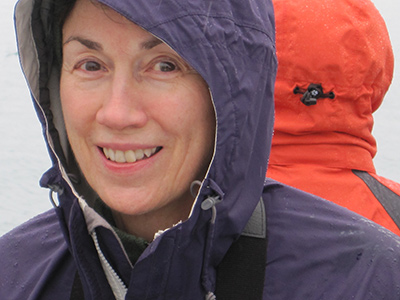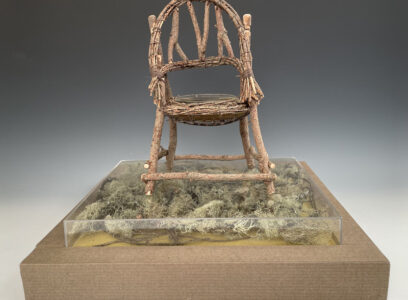Margo Klass
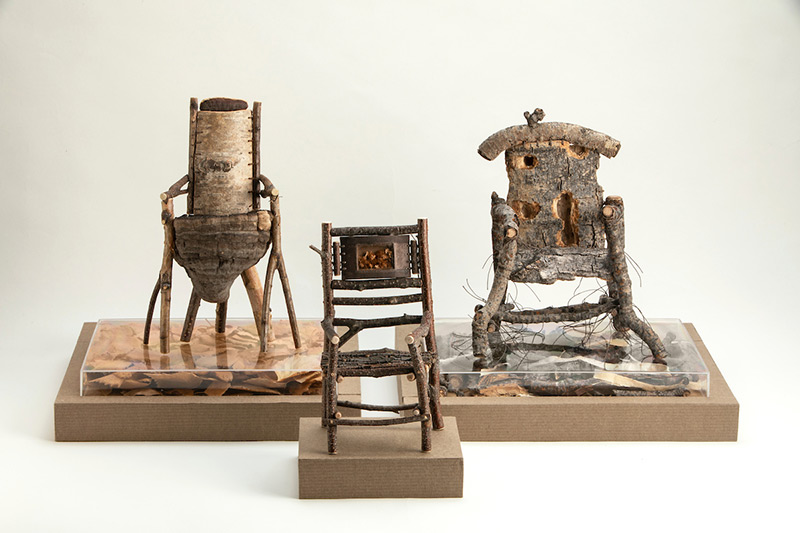
I am grateful to the following friends, colleagues, and scientists who provided information, technical assistance, and inspiration for Come Sit With Me:
Susan Campbell
Corinna Cook
Jan Dawe
Fred DeCicco
Joan Foote
Dan Gibson
Aren Gunderson
Cindy Lippincott
Mary Liston
John Manthei
Phil Marshall
Jon Miller
Peg Schaffhauser
Ken Severin
Statement
The boreal forest beckons us. Look down – the rich micro-world of the forest floor is at your feet. Look up – the boreal canopy is a cathedral of light and space. Come Sit With Me invites you into the boreal forest to look intently, listen carefully, and think deeply.
Suzanne Simard’s book Finding The Mother Tree provided inspiration for Come Sit With Me. Simard’s work as a forest ecologist reveals how the trees of the boreal forest form “a web of interdependence, linked by a system of underground channels, where they perceive and connect and relate with an ancient intricacy and wisdom….”. She describes how a forest is not merely a collection of trees, but a connected, codependent community of trees, plants, fungi, and microbes.
Come Sit With Me is a gathering of chairs that articulates this interdependence. Each chair is created from twigs, bark, seeds, and other parts of a particular tree. Together they represent the dominant trees surrounding my home: birch, white spruce, alder, aspen, and willow.
Each chair has a story to tell. Sometimes the story relates to the life cycle of a tree, as in Bracket Chair, whose seat is an upside-down bracket fungus commonly found on the trucks of dying birch trees. Other chairs tell a personal story, as in Fallen Crone. Composed of fragments of wood riddled with woodpecker holes, this chair recalls the loss of an already decayed but still standing aspen which suddenly toppled in a windstorm.
Some of the chairs sit on bases containing elements from the forest floor that relate to the specific chair. For example, spruce twigs feathered with moss are beneath Owl’s Call, and dried autumn birch leaves underlie Bracket Chair.
Miniature artist books, paired with some of the chairs, elaborate their stories. Bracket Chair includes a booklet containing highly magnified images of a bracket fungus as seen through a scanning electron microscope. The booklet accompanying Owl’s Call presents bones from the many voles consumed by the owl and regurgitated in its pellet. Look closely. Some of the bones are also contained in the seat of the chair.
These chairs, their bases, and the small artist books form a symbolic boreal community. Listen. The forest beckons, “Come sit with me.”
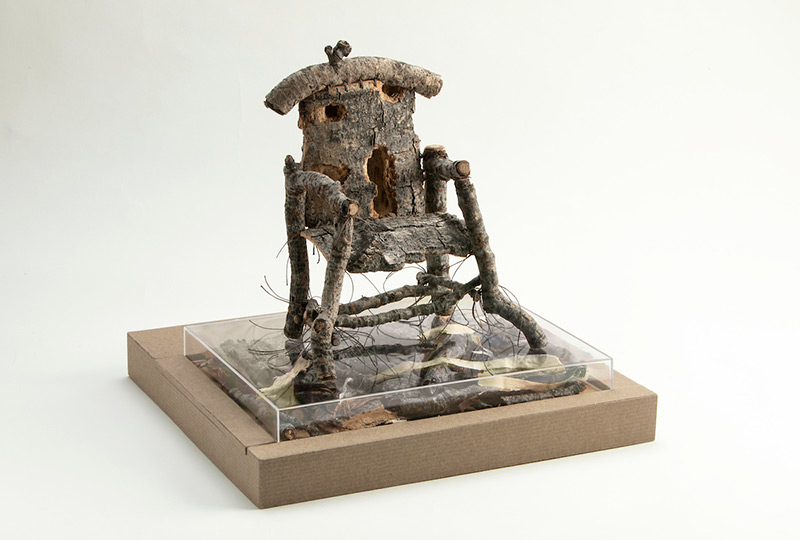
Fallen Crone (aspen)
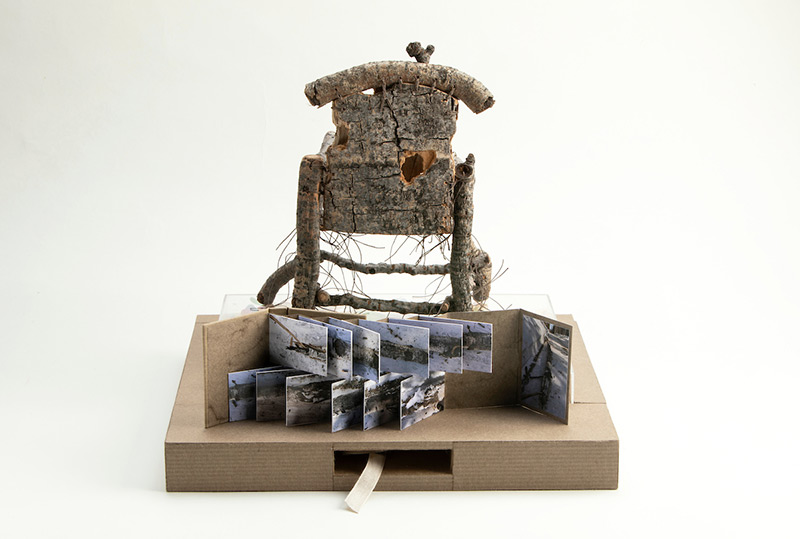
I was fond of the three decayed and hollowed-out aspen trees I passed on my daily walks. I thought of them as crones, wise elders who stood proudly among younger, flourishing trees. In April a windstorm came through and one of them fell into the adjacent road as I walked with my friend Mary Liston. Together we gathered armfuls of water-logged and fragmented wood, outer bark mostly, some of which was patterned with holes made over the years by hungry woodpeckers. The chair had to be laced together (not drilled and pegged) because the wood was so soft. The little book accompanying this chair photographically documents the fallen tree before it was removed from the road.

Owl’s Call
(white spruce)
Several times I have heard the owl call from high spruce branches on the UAF ski trails, creating for me a meaningful association between spruce and owl. When Cindy Lippincott gave me a richly endowed owl pellet I naturally coupled it with my white spruce chair. The dissected owl pellet appears under magnification in the chair’s seat and also in the chair’s miniature artist book. Aren Gunderson identified the vole bones as those belonging to the genus Microtus, most likely Microtus oeconomus, the second most common vole in Alaska. The curved tooth is a lower incisor, stained orange from iron, just like a beaver’s tooth.
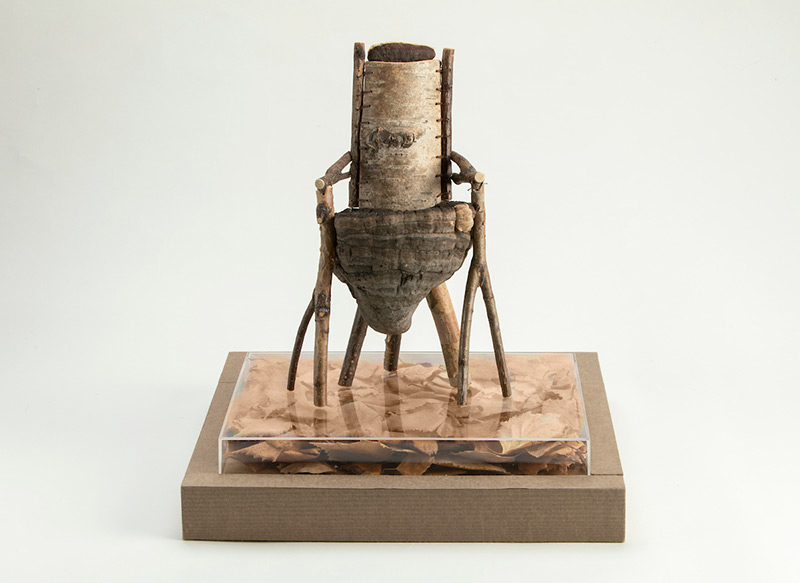
Bracket Chair
(birch)
I’ve been picking up birch fungus of all sizes for a long time, marveling at their variety of sizes, colors, and forms. Reviewing my collection with Fred DeCicco one day, he turned a bracket fungus upside down and noted how it turned into a very serviceable chair seat. That suggestion seeded my design as I fabricated the chair’s back, legs, rungs, and arms around it. The book embedded in its base features highly magnified photos of fungus surfaces, imaged in a SEM (Scanning Electron Microscope) workshop offered by Ken Severin for ITOC participants.

Seedlings
(birch)
I’ve been in conversation with Jan Dawe about birch trees for many years as both colleague and student. This little chair, one of the first made in the series, is a tribute to the scholarship and citizen science she promotes through OneTree Alaska. Birch twigs form all parts of the chair, including very small ones, which make the woven seat. A collection of wing-shaped birch seeds is displayed in a window of mica on the chair back’s panel, sewn in place like a picture on a wall

Rootwood
(white spruce)
Another chair fabricated exclusively with bookmaking threads, Rootwood recalls a walk on the Grand Spruce Trail in Goldstream Valley, introduced to me by Peg Schaffhauser. Also known as “The Path of the Grandmothers,” this trail features a section of monumental spruce whose ages easily exceed 150-200 years according to Joan Foote who accompanied us on the walk. Near the trail we found one of these mighty spruces fallen, its wood brittle and fractured in what was to me an atypical pattern. Joan suggested that we call this wood, located at the very base of the tree, root wood. It was dry and fragile, but pieces proved strong enough for cutting and sewing together.

Mary’s Wings
(alder)
My nature-loving friend, Mary Liston, gifted me a beautiful butterfly specimen at least two years ago. It sat in its decorated box until this project came along when I knew it had to be part of this project. The chair frame is alder, laced and pegged together. The combination of bent and twisted twigs that form the chair’s back offers a sturdy display place for the butterfly. Thanks to Dan Gibson for identifying its genus as Colias, fairly common throughout Alaska.
The chair is an object designed for sitting. As a symbol it conveys ideas of power, loss, rest, and contemplation. In my sculptural box constructions I have long used chairs to represent what I call the “seat of self,” a stand-in for the essence of personhood, sometimes but not always referring to myself.
Early in the Boreal Forest Stories project, ITOC participants gathered at Bonanza Creek for a day of presentations and activities. Corinna Cook led one of those sessions and in it she asked us to respond with observations, both factual and personal, to our boreal surroundings. In my responses Come Sit With Me began to take form. My hope was that the visual art I created would speak for the forest, inviting empathy, learning, and reciprocal care.
The chair-form would be the perfect symbol of the idea that the forest invites us in to participate in its life, legacy, and ecology.
I began by assembling a book of chair images – historical and contemporary chairs, chairs made of metal, fabric, and wood, chairs that looked like chairs, and some that didn’t. This album of chairs became a resource when I needed ideas, for example, for how to connect seats and backs, how legs are braced, how arms are secured.
My goal was to create sculptural objects that express “chair-ness,” as opposed to making traditional chairs in miniature. I allowed myself to discard certain notions, such as a chair is symmetrical, or a chair always has four legs. Inspirational in this regard was the craft and imagination of Phil Marshall, woodworker extraordinaire, whose chairs routinely break traditional rules of “chair-ness.”
Fabrication of the chairs did not – really could not – follow traditional woodworking practices. Working small was one issue, but also working with wood that was brittle, punky, wet, or otherwise challenging was another. I often resorted to techniques I knew best – those of bookmaking. When I couldn’t drill and peg pieces together, I could lace or knot them together using bookmaking tools and sewing techniques. One of the chairs, Fallen Crone, is exclusively sewn together. More typically the chairs are fabricated using a pegging technique learned at a Folk School class with inspirational teacher John Manthei, whose masterful craftsmanship was for me an elusive goal. Without much woodworking experience of my own I found I had to invent “whatever worked” to fabricate my fanciful notion of forest chairs, a process both challenging and joyful.
Margo Klass
Margo Klass is a mixed media sculptor whose work includes constructions and artist books. In both, natural and found objects are springboards for content, often narrative but always symbolic of meaning beyond what the objects suggest. Aesthetically she draws from her study of medieval art and her travel in Japan. She has received awards from the Rasmuson Foundation and Alaska State Council on the Arts. In 2015 she received the Governor’s Individual Artist Award. Her work is in the Alaska State Museum, Anchorage Museum, University of Alaska Museum of the North, Pratt Museum, and other public and private collections.
Website: margoklass.com
